



Impacting Social Determinants of Health with Homeless Populations Through Innovations in Health Professions Education: A Unique Partnership between Saranam, a 2Gen Service Organization, and the University of New Mexico Medical School DR. CYNTHIA ARNDELL TRACY SHARP WEAVER
CYNTHIA ARNDELL , MD, FACP, PROFESSOR EMERITUS, UNIVERSITY OF NEW MEXICO SCHOOL OF MEDICINE Carndell@jamestryonmd.com TRACY SHARP WEAVER, LPC, EXECUTIVE DIRECTOR, SARANAM saranam.tracy@gmail.com saranamabq.org
Who would have thought that a partnership with a medical school would have a great impact? We were surprised, too!
Goals/Objective Description: At the end of this session, attendees will be able to: 1. Describe current gaps in health professions education addressing the impact of homelessness and social determinants on individual and population health. 2. Discuss best practices for developing curriculum to provide our future healthcare taskforce with the understanding and resources for addressing social determinants of health (SDOH). 3. Explore local partnerships for providing service based learning opportunities for students, service providers and community members to address SDOH. 4. Describe ways local service providers can educate clients on SDOH as a means to empower clients to improve health outcomes, socio-economic, and family outcomes.
WHY SHOULD WE CARE?
POVERTY – THE MOST IMPORTANT DETERMINANT OF ILLNESS WORLDWIDE
HOW DO WE DEFINE HEALTH? We must go beyond the definition of health as absence of infirmity and instead define it as the extent in which an individual or population is able to realize aspirations, satisfy needs, and to change or cope with their environment. Health is a resource for everyday life, that is, the individual’s ability to handle stress, acquire skills, and maintain relationships — all of which form resources for resiliency and independent living. ~ WORLD HEALTH ORGANIZATION (WHO)
HOW COULD INCOME (OR WEALTH) AFFECT HEALTH? Income can directly shape: - Medical care - Housing options - Nutrition & physical activity options - Neighborhood conditions - Stress Parent’s income directly shapes the next generations’: - Education - Working conditions - Income
EFFECTS OF HOMELESSNESS ON HEALTH - Inadequate nutrition - Chronic stress and sleep deprivation - Exposure to the elements/temperature extremes - Lack of safety on the streets - Higher rates of violence and trauma - Higher rates of childhood illnesses and development delay - Higher rates of uncontrolled heart disease, blood pressure, diabetes, etc. in adults - Higher rates of depression and mental illness - Lower life expectancy
Q1. WHAT IS YOUR EXPERIENCE IN INCREASING PUBLIC AWARENESS AND ADVOCACY IN ADDRESSING SDOH AND/OR HOMELESSNESS IN YOUR COMMUNITY? Think about: 1. What are the internal/external drivers influencing the development of program? - Individual history, gaps in service model/medical training model 2. Who are your potential partners? - Overarching goal is same = upstream interventions to end poverty - How we get there is different: Saranam and UNM Medical School 3. What is the overall goal of this activity? - Upstream/downstream - Root causes Design Framework for Interpersonal Education Initiatives, Nasmith, L., Oandasan, I, Waters, I, Purden, (2003). Interdisciplinary education in Primary Health Care: moving beyond tokenism. College of Family Physicians of Canada Family Medicine Forum 2003, Calgary, Alberta, Canada. www.ipe.utoronto.ca/educators/framework.html
SARANAM – A DIFFERENT MODEL Saranam History: 15 years in operation Successful 2-year program for families Privately funded & financially sound 2 generational approach Trauma informed 80% success rate Longitudinal success
2-GEN APPROACH
Q2. WHAT IS YOUR EXPERIENCE IN PARTNERING SERVICE AGENCIES WITH ACADEMIC INSTITUTIONS AROUND SDOH? HOW COULD YOU ENVISION STRENGTHENING/CREATING PARTNERSHIPS? 1. What are opportunities within your current learning environment? - Innovative partnerships - Innovative service models - Innovative teaching methods - Barriers/Difficulties 1. Key players 2. Specific objectives - Value/Relevancy 3. Teaching Methods - Compare/Contrast organizations - Up/Downstream - Family and student activities
Q3. CHALLENGE: WHAT KINDS OF INNOVATIONS CAN YOU CONSIDER? NEW IDEAS? HOW DOES THIS IMPROVE YOUR COMMUNITY? WHAT ARE IMPORTANT QUESTIONS, BARRIERS TO OVERCOME? HOW CAN YOU VISION IMPLEMENTING EDUCATIONAL PARTNERSHIPS OR USING INFORMATION TO IMPROVE CLIENT/PATIENT OUTCOMES? 1. How will you evaluate the activity? What is the impact? - Saranam families - Students/Faculty - Service agency – Saranam’s organizational depth - Community – changed systems (health system and individual family health) 2. Sustainability - Where to go from here?
FINAL THOUGHTS & QUESTIONS Ways partnering with UNM Medical Students strengthened Saranam and families: - Empower families to take responsibility of heath and education/career choices - Gave families a voice and insight into medical training. There is power in telling your story. - Families access to health related fields - Partnerships leverage relationships for growth and support Ways Saranam families strengthened development of poverty medicine curriculum: - Context of patient environment is important, relevant - Break down barriers - Faculty also came to see relevance and increased Saranam visibility
WHAT WILL YOU DO NEXT?
Recommend
More recommend